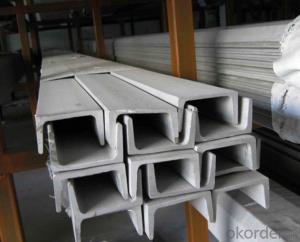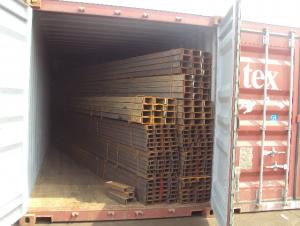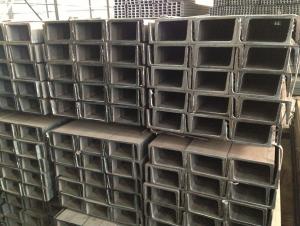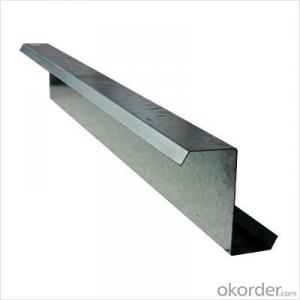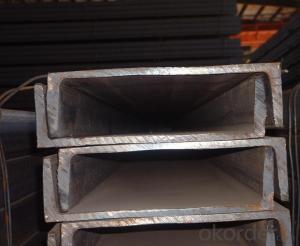JIS U CHANNEL HOT ROLLED HIGH QUALITY Q235
- Loading Port:
- Qingdao
- Payment Terms:
- TT OR LC
- Min Order Qty:
- 25 m.t.
- Supply Capability:
- 10000 m.t./month
OKorder Service Pledge
OKorder Financial Service
You Might Also Like
channel Details:
| Minimum Order Quantity: | Unit: | m.t. | Loading Port: | ||
| Supply Ability: | Payment Terms: | Package: | wire rod bundle |
Product Description:
Product Description:
Specifications of MS Channel:
1.We supply high quality MS Channel at reasonable price, including Chinese standard, Japanese standard and so on.
Standard | GB/JIS |
Material Grade | Q235,SS400 |
Technique: | Hot Rolled |
Sizes as per chinese standard: | 50*37*4.5mm - 300*89*11.5mm |
Sizes as per japanese standard: | 50*25*3mm – 200*80*7.5mm |
Length: | 6meter, 9meter, 12meter |
Note: 1.we are also competent to provide our customers other MS Channel based on other sizes according to customer’s requirements.
2. The length of our ms channel could be cut into other meters as per customer’s requirements. For example, the channel in 6meters could be cut into 5.8meters in order to be fit in the 20ft container.
2. The detailed sections of MS Channel as per GB standard.are shown in the table-1:
GB U CHANNEL | Standard | Sectional | Dimension |
| Mass: |
(mm) | (mm) | (mm) | (mm) | ||
50X37 | 50 | 37 | 4.50 | 7.0 | 5.438 |
63X40 | 63 | 40 | 4.80 | 7.5 | 6.634 |
80x43 | 80 | 43 | 5.00 | 8.0 | 8.045 |
100x48 | 100 | 48 | 5.30 | 8.5 | 10.007 |
120x53 | 120 | 53 | 5.50 | 9.0 | 12.059 |
140x58 | 140 | 58 | 6.00 | 9.5 | 14.535 |
140x60 | 140 | 60 | 8.00 | 9.5 | 16.733 |
160x63 | 160 | 63 | 6.50 | 10.0 | 17.240 |
160x65 | 160 | 65 | 8.50 | 10.0 | 19.752 |
180x68 | 180 | 68 | 7.00 | 10.5 | 20.174 |
180x70 | 180 | 70 | 9.00 | 10.5 | 23.000 |
200x73 | 200 | 73 | 7.00 | 11.0 | 22.637 |
200x75 | 200 | 75 | 9.00 | 11.0 | 25.777 |
220x77 | 220 | 77 | 7.00 | 11.5 | 24.999 |
220x79 | 220 | 79 | 9.00 | 11.5 | 28.453 |
250x78 | 250 | 78 | 7.00 | 12.0 | 27.410 |
250x80 | 250 | 80 | 9.00 | 12.0 | 31.335 |
250x82 | 250 | 82 | 11.00 | 12.0 | 35.260 |
280x82 | 280 | 82 | 7.50 | 12.5 | 31.427 |
280x84 | 280 | 84 | 9.50 | 12.5 | 35.823 |
280x86 | 280 | 86 | 11.50 | 12.5 | 40.219 |
300x85 | 300 | 85 | 7.50 | 13.5 | 34.463 |
300x87 | 300 | 87 | 9.50 | 13.5 | 39.173 |
300x89 | 300 | 89 | 11.50 | 13.5 | 43.883 |
Table-1
3. The chemical composition of HR Channel Steel according to Q235B is shown in Table-2.
Alloy No | Grade | Element(%) | ||||
C | Mn | S | P | Si | ||
Q235 | B | 0.12-0.20 | 0.3-0.7 | ≦0.045 | ≦0.045 | ≦0.3 |
Table-2
Note: we are able to present our customers relevant SGS test report for chemical composition of HR Channel Steel.
4. The mechanical property of HR Channel Steel according to Q235B is shown in Table-3-1 and Table-3-2
Alloy No | Grade | Yielding Strength Point(Mpa) | |||
Thickness(mm) | |||||
≦16 | >16-40 | >40-60 | >60-100 | ||
≧ | |||||
Q235 | B | 235 | 225 | 215 | 205 |
Table-3-1
Alloy No | Grade | Tensile Strength(Mpa) | Elongation After Fracture(%) | |||
Thickness(mm) | ||||||
≦16 | >16-40 | >40-60 | >60-100 | |||
≧ | ||||||
G235 | B | 375-500 | 26 | 25 | 24 | 23 |
Table-3-2
Note: we are able to present our customers relevant SGS test report for mechanical property of MS Channel as customer’s request.
Applications of MS Channel:
The MS Channel can be applied to construction of warehouses, workshops, sport stadiums and car parks etc.The hot rolled channel steel belongs to carbon structural steel which is applied to in the field of construction and machinery.In details, the hot rolled channel steel is usually used for arch-itechtural structure, and they could be welded in order to support or hang a vari-ety of facilities. They are also usually used in combination with I beam. Generally,the hot rolled channel steel we supply must possess perfect welding property, riveting property and mechanical property and so on.
Package & Delivery of MS Channel:
1.The hot rolled channel steel will be packed in bundle with steel wire at each end of every bundle and color marking in order to help the customer to recognize his goods more easily at sight.
2. And the hot rolled channel steel could be loaded into 20ft or 40ft container, or by bulk cargo.If the weight of each bundle reaches more than 3.5 mt, the loading by break bulk cargo should be choosed.When the weight of each bundle reaches less than 3mt, the loading by container should be choosed.
3.As for the transportaion from mill to loading port, the truck will be usually used. And the maximum quantity for each truck is 40mt.
4.All in all, we could do in accordance with customer's request
- Q:How do steel channels contribute to LEED certification?
- Steel channels can contribute to LEED certification by fulfilling various sustainable building requirements. They can aid in achieving points in the Materials and Resources category, as steel channels are often made from recycled materials and, when their lifespan is over, can be easily recycled again. Additionally, steel channels can contribute to energy efficiency and indoor air quality, as they can be used in the construction of energy-efficient building envelopes and HVAC systems. Moreover, steel channels are durable, long-lasting, and low-maintenance, reducing the need for replacements or repairs, thus minimizing waste generation. Overall, incorporating steel channels in a construction project can enhance its sustainability and help in obtaining LEED certification.
- Q:Can steel channels be welded or bolted together?
- Steel channels can be joined together either by welding or bolting. Welding involves melting the edges of the channels, allowing them to cool and solidify, resulting in a robust connection. This technique is commonly utilized for permanent connections that demand high strength. Conversely, bolting entails using bolts and nuts to secure the channels. This method is frequently employed when the connection needs to be adjustable or temporary. Both welding and bolting offer dependable and strong connections for steel channels, but the decision between the two depends on the specific application and requirements.
- Q:What is the weight of a steel channel?
- The weight of a steel channel can vary depending on its dimensions and size. To determine the weight, you need to know the specific measurements and consult a steel channel weight chart or use a formula to calculate it.
- Q:Can steel channels be used for creating support structures for plumbing systems?
- Yes, steel channels can be used for creating support structures for plumbing systems. Steel channels are known for their strength and durability, making them suitable for supporting the weight of plumbing pipes and fixtures. They provide a stable and secure base for plumbing systems, ensuring that pipes are properly supported and aligned. Steel channels also have high load-bearing capacities, enabling them to withstand heavy loads and prevent sagging or bending of the pipes over time. Additionally, steel channels can be easily customized and fabricated to meet the specific requirements of the plumbing system, making them a versatile choice for creating support structures.
- Q:How do steel channels contribute to the flexibility of architectural designs?
- Architectural designs benefit greatly from the unique properties and characteristics of steel channels, as they provide flexibility and versatility. These structural elements offer numerous advantages that enable architects and designers to create more adaptable structures. To begin with, steel channels possess a remarkable strength-to-weight ratio, allowing them to bear heavy loads while keeping the overall weight of the structure to a minimum. This quality permits architects to design buildings with larger open spaces, longer spans, and taller heights, without the need for excessive columns or other structural elements. As a result, architects have the freedom to create more visually appealing and spacious areas. Furthermore, steel channels exhibit exceptional durability and resistance to various environmental factors, such as corrosion, fire, and extreme weather conditions. This durability ensures that the structure will have a longer lifespan and reduces maintenance costs. It also enables architects to design buildings that can withstand challenging environments, including coastal areas or regions prone to earthquakes or hurricanes. The flexibility provided by steel channels in terms of withstanding different conditions allows architects to design structures in diverse locations and climates. Additionally, steel channels can be easily fabricated, customized, and assembled on-site. This versatility in fabrication allows architects to create intricate and distinctive shapes, curves, and profiles that enhance the visual appeal of the design. Steel channels can be easily manipulated through cutting, bending, and welding to achieve various configurations, enabling architects to bring their creative visions to life. Moreover, this flexibility in customization facilitates seamless integration with other building materials, such as glass, concrete, or wood, allowing architects to combine different materials for improved aesthetics and functionality. Moreover, steel channels are readily available and cost-effective. Their widespread availability simplifies the sourcing of materials, eliminating potential delays in construction projects. Additionally, their cost-effectiveness makes them a preferred choice for many architectural designs, providing an economical solution without compromising on strength or durability. In conclusion, steel channels contribute significantly to the flexibility of architectural designs by offering a high strength-to-weight ratio, durability, customization options, and cost-effectiveness. These properties empower architects to design structures with larger open spaces, unique shapes, and increased resistance to environmental factors. The versatility of steel channels enhances the overall flexibility of architectural projects, enabling the creation of aesthetically pleasing and functional designs that can withstand various challenges.
- Q:How do steel channels contribute to the overall stability of a structure?
- Steel channels contribute to the overall stability of a structure by providing structural support and reinforcement. They are often used as beams or columns, distributing the load and transferring it to the foundation or other supporting elements. Their shape and material properties enhance their strength and stiffness, allowing them to withstand bending, torsion, and other forces that can cause structural instability. Additionally, steel channels can be strategically placed to resist lateral movements and vibrations, ensuring the stability and integrity of the entire structure.
- Q:What are the different installation techniques for steel channels?
- There are several different installation techniques for steel channels, depending on the specific requirements and intended use of the channels. Here are a few common methods: 1. Welding: One common technique is to weld the steel channels to the supporting structure. This involves using a welding machine to melt the metal and create a strong bond between the channel and the structure. 2. Bolting: Another technique is to use bolts to secure the steel channels to the supporting structure. This method is often used when the channels need to be easily removable or adjustable. 3. Adhesive bonding: In some cases, adhesive bonding can be used to install steel channels. This involves using a strong adhesive to bond the channels to the supporting structure. Adhesive bonding can be a good option when welding or bolting is not feasible. 4. Mechanical fasteners: Steel channels can also be installed using mechanical fasteners such as screws, nails, or rivets. This method is typically used for lighter-duty applications or when a temporary installation is required. 5. Sliding or sliding-fit installation: For certain applications, steel channels can be installed by sliding them into pre-formed slots or grooves in the supporting structure. This method allows for easy installation and removal of the channels as needed. It is important to consider the specific requirements of the project, including load-bearing capacity, durability, and ease of installation, when choosing the most appropriate installation technique for steel channels. Consulting with a structural engineer or construction professional is recommended to ensure the proper installation method is chosen for the specific application.
- Q:What is the difference between channel steel and C steel?
- Channel steel is produced by hot rolling, supplied directly by iron and steel works, and thicker
- Q:How heavy is channel 1, 16? How do you calculate the formula?
- The channel weight per meter =0.00785 * [+e (high waist thick legs wide waist thick sand river)]
- Q:What are the different bending techniques for steel channels?
- Steel channels can be bent using various techniques, depending on the desired outcome and the equipment at hand. Some popular bending techniques for steel channels are as follows: 1. Roll Bending: By passing the steel channel through a series of rolls, it can gradually be shaped into the desired form. Roll bending can be performed in different ways, such as pyramid rolling, which utilizes three rolls to create a pyramid shape, or double pinch rolling, which employs two rolls for a more uniform bend. 2. Press Bending: Utilizing a press machine, force is applied to the steel channel, resulting in its bending. This technique is often employed for smaller channels or when a tighter radius is required. Press bending can be executed with the aid of a V-die, ensuring a smooth bend, or a bottom bending die for more intricate shapes. 3. Induction Bending: This technique involves heating the steel channel to a specific temperature using an induction coil, making it more pliable. Once heated, a bending machine or a set of rolls is used to bend the channel. Induction bending is commonly used for large or thick steel channels that necessitate precise and consistent bends. 4. Rotary Draw Bending: A mandrel and a set of dies are employed in rotary draw bending to bend the steel channel. The mandrel is inserted into the channel to prevent wrinkling or collapsing during the bending process. This technique is often utilized for tight radius bends or when maintaining the structural integrity of the channel is of utmost importance. 5. Stretch Bending: By clamping the ends of the steel channel and applying force, it can be stretched over a mandrel or a form. Stretch bending is commonly employed for larger channels or when creating long, sweeping curves. Each bending technique offers its own advantages and limitations, and the choice of technique depends on factors such as the desired bend radius, the thickness of the steel channel, and the available equipment. It is crucial to consider the specific requirements of the project and seek guidance from professionals in order to determine the most appropriate bending technique for steel channels.
1. Manufacturer Overview |
|
|---|---|
| Location | |
| Year Established | |
| Annual Output Value | |
| Main Markets | |
| Company Certifications | |
2. Manufacturer Certificates |
|
|---|---|
| a) Certification Name | |
| Range | |
| Reference | |
| Validity Period | |
3. Manufacturer Capability |
|
|---|---|
| a)Trade Capacity | |
| Nearest Port | |
| Export Percentage | |
| No.of Employees in Trade Department | |
| Language Spoken: | |
| b)Factory Information | |
| Factory Size: | |
| No. of Production Lines | |
| Contract Manufacturing | |
| Product Price Range | |
Send your message to us
JIS U CHANNEL HOT ROLLED HIGH QUALITY Q235
- Loading Port:
- Qingdao
- Payment Terms:
- TT OR LC
- Min Order Qty:
- 25 m.t.
- Supply Capability:
- 10000 m.t./month
OKorder Service Pledge
OKorder Financial Service
Similar products
New products
Hot products
Hot Searches
Related keywords
